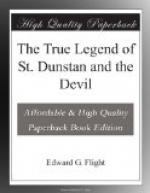“Who ever knew this honest brute
At law his neighbour prosecute;
Bring action for assault and battery,
Or friend beguile with lies and flattery?
“His proud step is on all fours with his love of a fair field and no favour. The grandeur of his nature is such, that the idea of a beggar on horseback is proverbially the most revolting of all inequitable absurdities and incongruities in human economy; while, on the other hand, as was once well remarked by a distinguished lecturer, this superb animal stamped his very name itself on that for which our loftiest princes and nobles, before the present degenerate age of iron, were emulous of distinguishing themselves. In proportion as they developed unblemished honour, with undaunted bravery, graceful bearing, and magnanimous generosity, were they deemed worthy to rank among Christendom’s bright chivalry.
“The horse-shoe was, no doubt, regarded as typical of the noble qualities of its wearer. These being so hateful to the ugly, sly, intriguing, slandering, malevolent, ill-conditioned, pettifogging, pitiful arch-enemy, it might well be supposed that the mere apparition of that type would scare him away. To this supposition is ascribable the adoption of the horse-shoe, as an infallible charm against the visits of old Iniquity.”
But mere “supposition” is no answer to the question above propounded.
* * * * *
An acknowledgment is due, and is hereby offered, to the unknown correspondent, who has obligingly communicated the following copy of the coat of arms of the Dunstan family.
“Azure, on a chevron gules between three harps, a horse-shoe supported by two pairs of pincers, proper. Crest—An arm embowed, couped at the shoulder, the hand grasping a hammer, all proper. Motto—’SARUED HYM RIGHTE.’”
[Illustration: SAREUD HYM RIGHTE]



